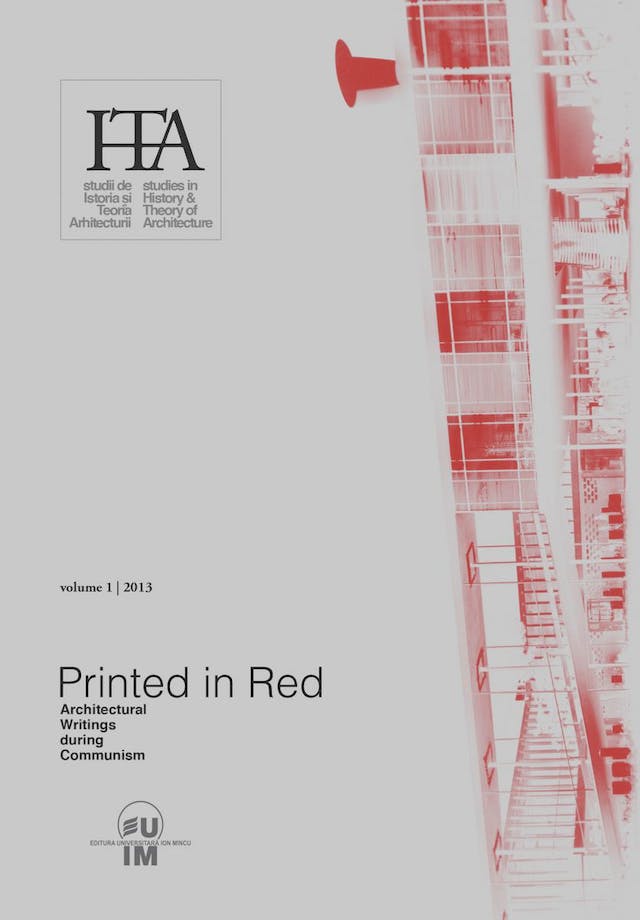Testing the Physiognomy of the Arhitectura Magazine (1952-1989)
by
Ana Maria Zahariade
Keywords
the Arhitectura magazine
ideology
political and professional thematic
editorial compass
On the effervescent but unsteady scene of architectural publications before the Second World War, the 36 issues of the Arhitectura magazine of the Society of Architects were, from 1906 until 1944, a benchmark of stability and consistency, in spite of the many interruptions and delays.
Its follower, ARHITECTURA RPR (renamed ARHITECTURA) is (re)born in 1952, after the communist regime was installed, by governmental decree, as "organ" of the Union of Architects. From 1953 until December 1989, issued without interruption, it would be the only architectural periodical extensively spread, due to its state funding.
Dedicated to architectural design, edited by the Union of Architects and written especially by architects, the new series has minutely and ceaselessly recorded the achievements of the period and the life of the profession. As such, it constitutes the main documentary source for deciphering the professional history during Communism; it has been widely used in recent researches. Yet, being the only publicly spread and easily accessible architectural periodical of communist Romania, ARHITECTURA was more than a passive witness, a mirror of history; we can presume that it was, in its own way, a "creator of history", an active participant in the professional history. This hypothesis brings into discussion the editorial policy of the magazine, its internal life, of which we know very little, still. Even though the magazine was financially supported by the state, the editors had to face rather unusual conditions, where professional and political missions met. While the archives of the Union of Architects are still closed and the editorial staff is no longer alive, the only resource on this matter is the magazine itself.
The article surveys the “surface” of the magazine, hypothesizing that this epidermal layer was a sensitive interface between the “voice” of the profession on one hand and the eye of censorship, on the other. The dynamics of this interface was modeled specifically by absorbing the never won but never lost game between the political authority – on which the mere existence of the magazine depended – and the architects’ expectations – to which the magazine responded with its professional identity. In the given circumstances, always politically determined, their meeting was initially conducted on the readily visible field that precedes the written discourse, before going in the deeper substance of the texts. This is why the article avoids discussing the content of the articles, except for the editorials; the same reason goes for the authors present in the issues.
The article describes the dynamic of the review’s physiognomy following chronologically:
(1) the periodicity and the dimensions of the issues;
(2) the turning points in the evolution of the magazine, identified through the consequent changes in title, patronizing institutions and editors, on the one hand, and the evolution of the graphic design (size, cover, first page, font, text formatting and illustrations, paper quality, etc.) on the other hand;
(3) the thematic structure as it may be deduced at this surface level from the editorials, the tables of contents and the yearly summaries, permanent rubrics and themed-issues.
As it is hardly believable that, in a society so deeply articulated under political control, the changes in form and thematic content could have been innocent, all these changes taken individually and as a whole, suggest a specific dynamics of the interplay between professional desire and political will: episodes of apparent slavery and lively episodes of probable editorial deliberation, paradoxical spaces of relative independence, which seem to follow the common thread of a professional idea opposing the ideological fluctuations; all these features are not necessarily typical for a professional magazine, but they are characteristic for publications under dictatorship. On these surface levels we find clues as to the editorial life of the magazine, still hidden and probably more agitated than we could intuit from the continuity of the publication, inflexion moments whose substance need to be thoroughly investigated. Until further data is available, we can only conjecture on the aspirations of the successive editorial boards. This is rather a possible history proposed as research hypothesis, which has conferred the magazine its particular meaning; this article tries to unveil this presumed meaning.
Published in

Chicago citation style
DOI:
10.54508/sITA.1.14
1 / 2013
Testing the Physiognomy of the Arhitectura Magazine (1952-1989)2 / 2014
Introduction. Behind the Big Picture2 / 2014
Professor Alifanti’s Notebooks3 / 2015
Introduction. Avatars of an Elusive Concept5 / 2017
Introduction. Opening Limits1 / 2013
Foreword7 / 2019
Introduction. The Historicity of Modernism7 / 2019
Meeting Modernisms in Gdynia8 / 2020
Comment doit-on mesurer l’émotion? An interview with Vlad Gaivoronschi9 / 2021
Low-Rise High-Density “Semi-Collective” Housing. Thoughts, Ideas, and Proposals Over Four Decades10 / 2022
Le Temps Retrouvé10 / 2022
Play Is All about the Interplay of Chance and Rule